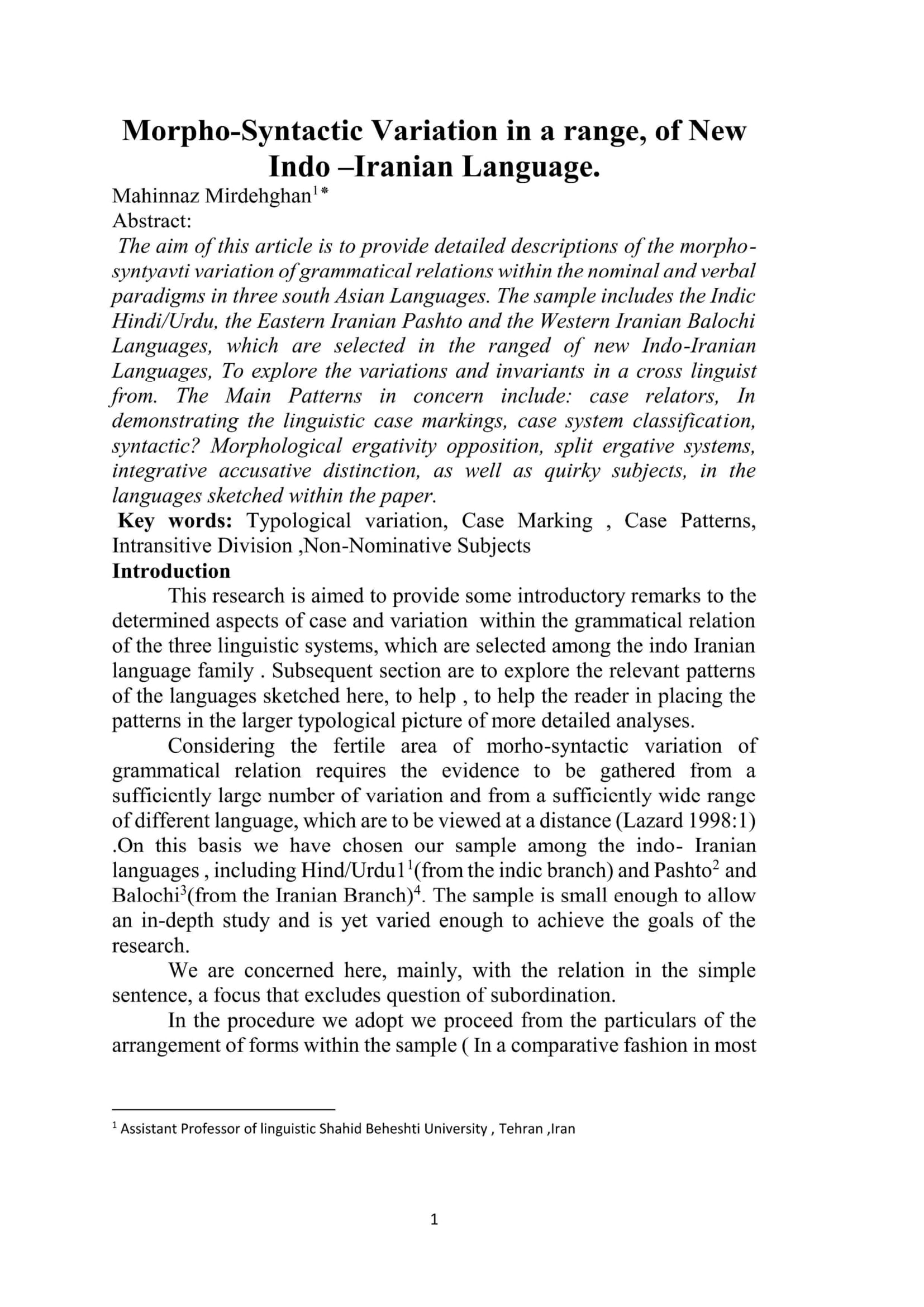Morpho-Syntactic Variation in a range, of New Indo –Iranian Language.
Keywords:
Typological variation, Case Marking , Case Patterns, Intransitive Division ,Non-Nominative SubjectsAbstract
The aim of this article is to provide detailed descriptions of the morpho- syntyavti variation of grammatical relations within the nominal and verbal paradigms in three south Asian Languages. The sample includes the Indic Hindi/Urdu, the Eastern Iranian Pashto and the Western Iranian Balochi Languages, which are selected in the ranged of new Indo-Iranian Languages, To explore the variations and invariants in a cross linguist from. The Main Patterns in concern include: case relators, In demonstrating the linguistic case markings, case system classification, syntactic? Morphological ergativity opposition, split ergative systems, integrative accusative distinction, as well as quirky subjects, in the languages sketched within the paper.
References
Hindi and Urdu language . are consider by most linguist to show the same grammatical structure , the difference being that hindi is writtern in Devanagari and draws vocabulary from Sanskrit while urdu is writer in Arabic script and drwas vocabulary from Persian and Arabic.
Pashto belongs to the southeastern group within the Iranian branch of indo Iranian ,and is a major language of aghaistan and Pakistan basically this research is centred on the dialiect of khandahar , Afghanistan .
Balochi , is the principal language of Balochistan and a northwestern Iranian language of the Iranian branck of indo Iranian ( belongin to the indo European language supe family ) which is situated in the south eastern corner of the Iranina language group . This study has been focused on the southern Balochi dialect which shows a quite consistent use of ergative stricter (see,3 for a disc ission of ergative case patterns)
The inventory of vowel phonems of the sample language that can also cesve as key to the tranccrption in the paper are presentbelow.
Hindi/Urdu vowel Pashto vowels Balochi vowels
front center back
front center back
front center back
High ii uu Ii uu Ii uu
I u A u A u
Midhigh E o W o E o
Mid low Ai a au A
Low aa A aa A aa
In the above table the sounds in brackets are phonoems that are limited to elegant and formal styles in Pashto (penzl1955,14)
Throughtout the paper capital letters are used to show nasal vowels and eretroflex consonats and bold forms to show agreement.
Owing to the differing system of the sources transcription and glossing of the examples are puit to a unified system
Its to be noted that the rela tors here are used to describe the cas patterns of the language under incestigation
There are also addition classtication to be condedered in other language such as those indicate by morphemes incorporated in the verb form (e.g in totonac langauges( mexico) cflazard1998.2) for a detail discussion on relator(actancy) instrument,seelazard1998
This classification is also referred to as head vs dependent marking (butt,2006,5)
In the language studied ere the contrast can be summarized as that of direct vsOblique cased the ddirect case representing the unmarked nominative and absolutive sases while the oblique case indexes the marked ergative and accusative one.
There are seven cases in hidi/urdu as indicated in the following table adapted from butt and king 2004:157) eac indicated by certain postpositon.
Case Nominatic Ergative Accusative dative
Instrumental genitive locative
postpostion O ne ko Se Kaa(m)
Kii(f0
E(obl) Me
Par
tak
Mohanan(1994:10) states that in future tenses Hindi/Urdu verb exhibis agreement for all three categories of number gender as well as person as seen in the example below .however for the non futer tense( past and perfective , considered mainly here) just number and gender are indexed with the verb .
Raam kitaaba khariideg-aa
Ram m sgnom bookf.pl.nmm bu,fut mssg
Reference:
Aissen ,Judith,1990 , Markedness and subject choice in optimality t heory in natioral language and linguisti theory 19,673,711( reprintened in Geraldine legendre et al (eds(
Aissen , Judith,2000,Differetial object marking Iconicity vs economy dragt online university of California ,santa cruz
Babrakzai ,Farooq 1999,topks in Pashto syntax ph.b thesis unierstity of hawai at manoa.
Bellti, Adriana, and luigi rizi, 1988 psych , verbs and theory natural language and linguist theory 6.291,352
Butt , Miriam2005 , theories of case Cambridge, Cambridge university press.
Butt , Miriam and tracy H.King 2004 the status of case in veneeta Dayal anoop Mahajan (eds) clause structure in south Asian langauged (studies in Natural language and linguistic theor 61) boston ets
Kluwer pp,152,198
Deo , ashwani and Devyani sharma ,2006 , typological variation in the ergative morphology of indo Aryan language linguist typoly 10,pp 369,419
Dixon , Robert 1994,Ergativity camrdge, cambrige university press
Dixon ,Robert , 1979 , egartivety language 55,pp59 , 138
Farrell,tim,1989: A study of ergativity in Balochi Ma thesis soas London
Farrell ,tim,1989: fading ergatici? A study of ergative in Balochi in :Davi Bennett , Theodora bynon , B George Hewitt(ed) subject voice and ergativity selected essays London , sosas pp 218.243
Fillmore , Charles , j1968 the case for case in universsals of linguistic theory, ed Emmon bach and Robert th harms 1-88 new York Holt Rinehart and Winston . Greenber jh 1963 universals of language 2nd cambrife mass the mit press
Kachro ,Yamuna , and rajeshwari , pandharipande,1979 , onergagative in selecte south Asian languages in south Asian language analysis , Urbana Dept of linguistc UIUC 193 , 209
Lazard Gilbert , 1998 Actancy, berlin new your mouton de fruiter gmb and co
Mannin Christopher 1996 Ergativity argument structure and grammaticla relation Stanford
Mohanan ,tara,1994 argument structur in hindi , stanfor,scli publication
Penzl ,Herbert 1955 , a grammar of Pashto adescripticestudy of the dialect of khandahar , afghan washinton American council of learned societies .
Plank , fran 1998 , ergativity syntactiv typology and unicersal gramm some past and present.
Trask Robert 1979 , On the origin of ergativity in frans Plank , Ergativitly toward a theory of grammatical relation new youkAcademic press pp385


